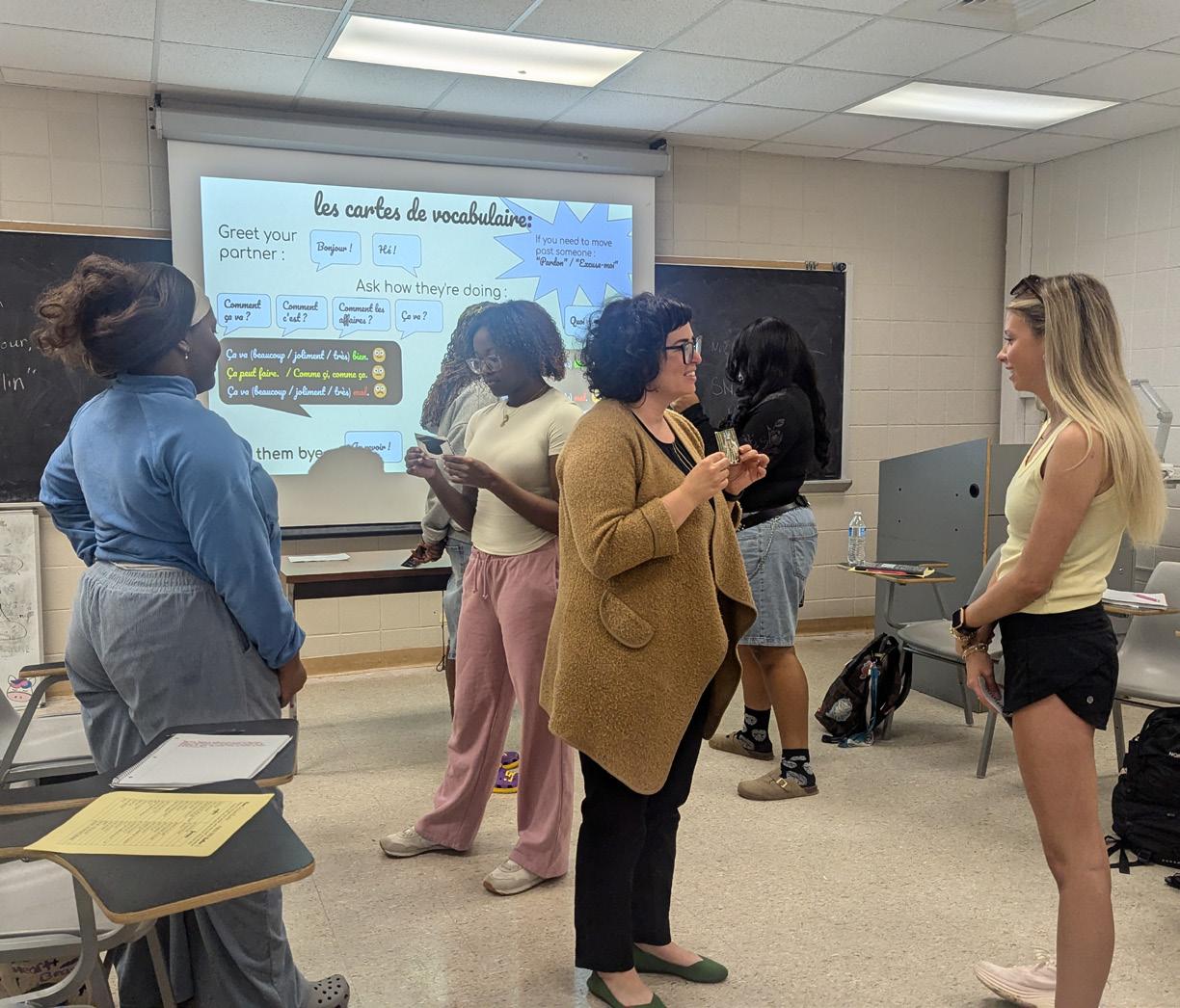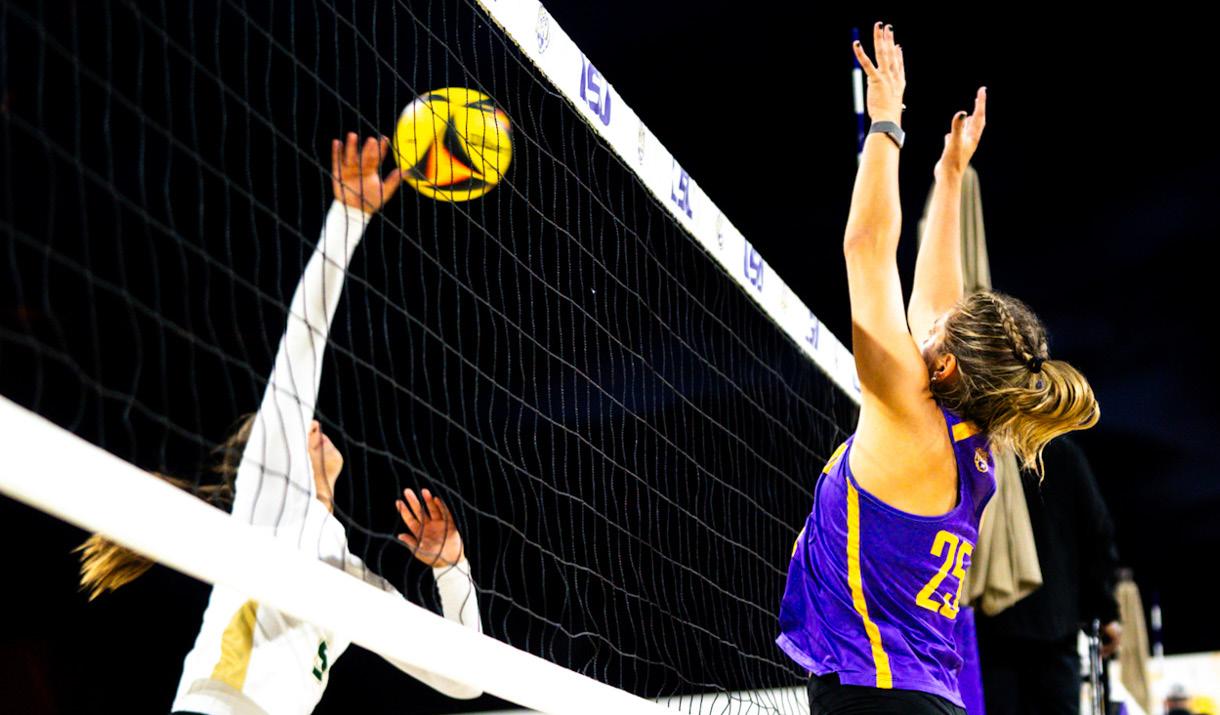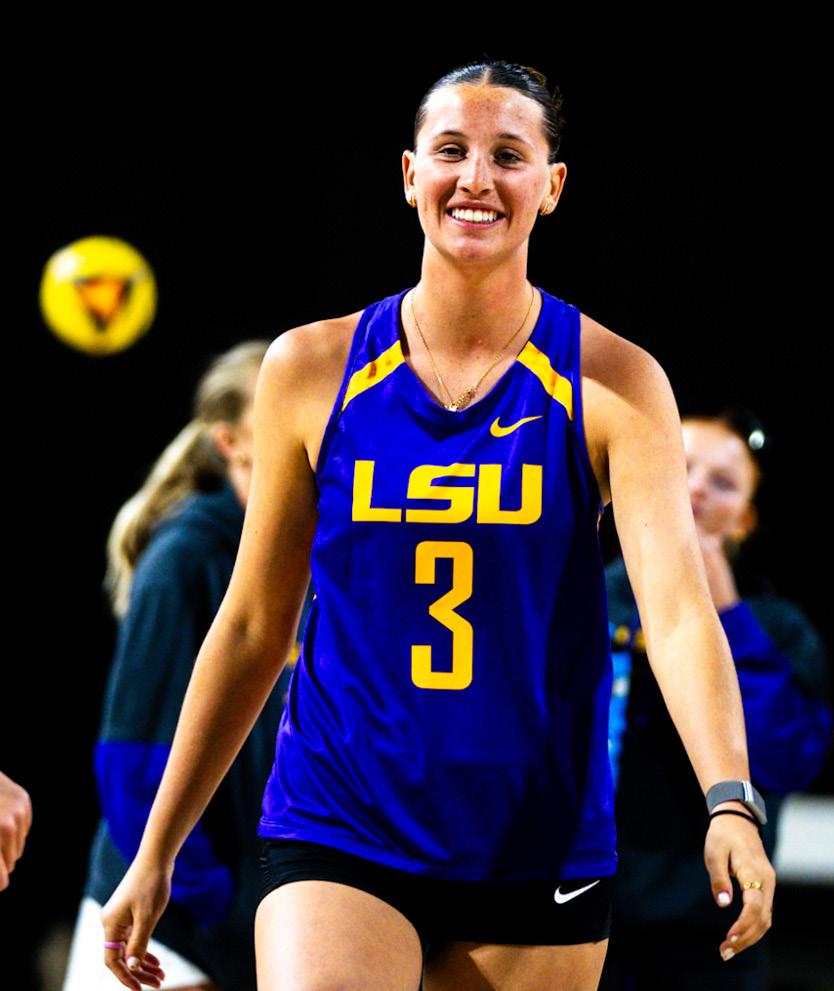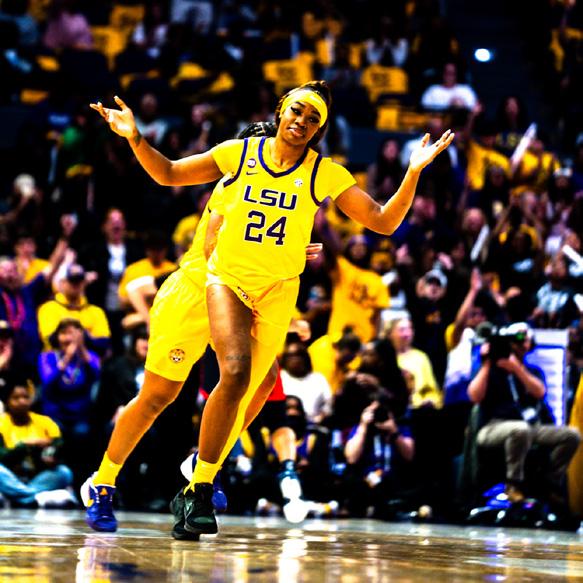

Manship won’t remove former deans’ obituaries in DEI purge, says Dean Kim Bissell.




Manship won’t remove former deans’ obituaries in DEI purge, says Dean Kim Bissell.

How Aneesah Morrow’s Chicago roots launched her stardom.






BY TYLER HARDEN Staff Writer
On Sunday, Aneesah Morrow secured her 28th double-double performance of the season with five-and-a-half minutes left.
Despite LSU losing to Ole Miss 85-77, Morrow’s doubledouble was historic. She became the second women’s college basketball player to reach 100 double-doubles.
“It’s hard being as consistent as I am,” Morrow said. “Every night, I have aches and pains, and I continue to fight through.”
Morrow is no stranger to fighting through adversity and hardship. She credits her grit to her parents, who helped pave the way for her success.
Growing up on the South Side of Chicago, however, Morrow was forced to grow up quickly despite her parents’ always-supportive nature.
Morrow was recently a guest on Flau’jae Johnson’s podcast, “The Best of Both Worlds,” where she briefly spoke of her past living in Chicago.
“Growing up in the city on the South Side, you see some things you shouldn’t see as a young girl,” Morrow said on the podcast. “I’ve been in [the] crossfire before. I’ve seen people take their last breath.”
But Morrow always embraced a city that showed her things that no one should see, let alone at eight years old. She showed her seemingly unconditional love for Chicago through basketball.
In her junior year of high school, Morrow led her Simeon Career Academy basketball team to its first girls’ basketball state title. She was a top 50-ranked recruit in the 2021 class, according to MaxPreps and Prospects Nation.
Regardless, Morrow decided to stay in her home city and play for DePaul.
“I wasn’t ready to go [away] to school,” Morrow said on a podcast with The Players Tribune. “I felt like DePaul was the closest school to home with that winning tradition.”
Despite staying in Chicago, Morrow’s career was set to take a big step. But her city knew the type of player she was, and she only proved them right.
Morrow started all 33 games her freshman season, leading the team with 21.9 points and 13.8 rebounds per game. Even as a true freshman, she led the country in rebounds per game and recorded double-doubles in 27 of DePaul’s 33 games.
She took things to the next level her sophomore year, averaging 25.7 points and 12.2 rebounds per game. Morrow ranked fourth in the NCAA in scoring and seventh in rebounding, the only player other than

Angel Reese in the top 10 in both categories.
The irony in that? Morrow and Reese would be teammates just a season later. After Morrow’s sophomore season at DePaul, she entered her name into the transfer portal.
The move meant she had to leave home, but home would never leave Morrow.
In the quest to find a new home away from home, South Carolina looked like a good fit for Morrow, as the Gamecocks lost their star post-player, Aliyah Boston, to the WNBA.
However, after a visit to Baton Rouge, Morrow committed to Kim Mulkey and the Tigers.
“I felt like the community, the atmosphere here was kind of crazy,” Morrow said. “Having people follow you, want pictures with you, just supporting you, that’s what I really loved about it.”
While Morrow’s first season in the Bayou forced her to share the wealth of rebounds with Reese, Morrow still shined. She averaged 10 rebounds and 16.4 points per game, including a 37-point, 16-rebound performance against Virginia in the Cayman Islands.
With Reese moving onto the WNBA after the 2024 season, Morrow was set to be a crucial leader for her senior season, and her game was now arguably more polished and defined than ever before.
But Morrow’s senior season included a trip to where it all started and a place she holds
near and dear to her heart. LSU was set to take on the University of Illinois-Chicago and was to do so in the Windy City.
The Tigers set similar hometown games for Reese in Baltimore, Maryland, and Mikaylah Williams in Bossier City, Louisiana.
“It’s not easy to always take them back home, but we try,” Mulkey said. “There’s something in your heart; I remember when I was a player, I always wanted to go back home and play in front of people that watched me grow up.”
Morrow could show her teammates and coaches her hometown, high school and where she grew up. She also had nearly 40 family members and friends attending the game.
“It was a great experience. I teared up a little bit,” Morrow said. “Just being able to see how much of an impact I’ve made was amazing.”
Morrow had herself an allaround impactful performance against the Flames, finishing with 19 points, 13 rebounds, three assists, four steals and two blocks.
An all-around performance was fitting for Morrow in her hometown because not only did Morrow show her love for Chicago through basketball, but also through her toughness.
Morrow stands at just 6-foot1, but regardless, she leads the country in rebounds by more than a rebound. Morrow often sees opposing players who may have a height advantage of two
inches or more, but she has still managed to record double-digit rebounds in all but three games this season.
“Morrow is a fantastic player on the block,” Stanford head coach Kate Paye said. “She demands a double team.”
To be at a disadvantage, height-wise, in arguably more games than not this season, Morrow has needed toughness and to play with a chip on her shoulder.
Luckily, she’s always played with a chip on her shoulder, and Chicago gave her that chip.
“She never tires. She never gets tired,” Mulkey said. “That kid is tough as nails. You just can’t imagine.”
Now, Morrow’s toughness will be visible to everyone as her college career goes down in history.
Morrow is the second women’s basketball player ever to reach 100 career double-doubles. She also became the eighth female basketball player to record 2,500 points and 1,500 rebounds in January against Vanderbilt.
“There’s no substitute for what that kid has inside of her heart,” Vanderbilt head coach Shea Ralph said of Morrow. “You can’t coach what she does. You either have that, or you don’t.”
With Morrow’s college career going down in history, a career in which she hopes ends with a national championship, it’ll now be for the women’s basketball world to see that Morrow’s toughness and love for the game comes from one place: Chicago.
Layout/Ad Design BEAU MARTINEZ
Layout/Ad Design
Layout/Ad
The Reveille holds accuracy and objectivity at the highest priority and wants to reassure its readers the reporting and content of the paper meets these standards. This space is reserved to recognize and correct any mistakes that may have been printed in The Daily Reveille. If you would like something corrected or clarified, please contact the editor at (225) 578-4811 or email editor@lsu.edu. ADVERTISING (225) 578-6090
The Reveille is written, edited and produced solely by students of Louisiana State University. The Reveille is an independent entity of the Office of Student Media within the Manship School of Mass Communication. A single issue of The Reveille is free from multiple sites on campus and about 25 sites off campus. To obtain additional copies, please visit the Office of Student Media in B-39 Hodges Hall or email studentmedia@ lsu.edu. The Reveille is published biweekly during the fall, spring and summer semesters, except during holidays and final exams. The Reveille is funded through LSU students’ payments of the Student Media fee.
BY MADISON PACELLI Staff Writer
Professor Erin Segura, a passionate advocate for the preservation of Louisiana French, has become a leader in efforts to revitalize the unique dialect at LSU.
With deep roots in the cultural fabric of Louisiana, Segura’s work focuses on both preserving and promoting the use of Louisiana French through her academic research, community engagement and innovative teaching methods.
“I get most of my inspiration from my students and in a variety of different ways,” Segura said. “There are the students who are heritage speakers, meaning that they have a familial connection to the language and are reclaiming it.”
Following a ban on teaching French in public schools in 1921, many Louisiana French speakers were unable to pass on the state’s unique dialect to younger generations. When these students became adults, whether out of fear of marginalization or shame, they taught their children little to no Louisiana French.
To combat the major loss of Louisiana French speakers due to this “lost generation,” French immersion schools, documentaries and podcasts throughout the state have made great efforts to vitalize this dialect, though challenges remain for the language.
“Misinformation and astigmatism towards Louisiana French is a major challenge,” Segura said.
As a final in one of Segura’s courses students must find and interview Louisiana French native speakers. However, as the years pass, it has been harder for students to find native speakers to interview. Segura’s commitment to teaching Louisiana French underscores the importance of language

as a key element of cultural identity and the ongoing struggle to keep Louisiana French alive.
Segura explained why she views the maintenance of the dialect as important, quoting her friend Jourdan Thibodeaux who said “languages don’t die . . . they’re killed by choice.”
“I think it’s time for people to take personal responsibility,” Segura said. “When someone says to me, ‘Why bother learning Louisiana French if it’s a dying language?’ My response is always, ‘If it’s dying, it’s because you’re not learning it.’”
The future of Louisiana French is in the hands of the younger generations who choose whether or not to speak it. Segura’s courses are one way younger generations are able to learn the language. At LSU, Segura is not only educating the next generation of French speakers, but also fostering a renewed sense of pride and connection to the lan-
guage within the broader Louisiana community.
Louisiana French and the French spoken in France share a great number of similarities, making it easier for speakers of these languages to communicate. What makes Louisiana French so unique are the accents that are native to Louisiana French speakers. With more than six different accents spread through Louisiana, the French that is spoken in the state is distinct.
“There is a group that I think of as ‘converts’ who are equally inspirational: these are students who’ve grown up with stigmatized notions of Louisiana French, and take the class because they think it will be ‘easier’ because it ‘isn’t real French’ or that it ‘doesn’t use grammar.’ They come to realize that these are misconceptions, and they’re

BY JASON WILLIS Managing Editor
The LSU Manship School of Mass Communication doesn’t plan to delete former deans Martin Johnson and Jerry Ceppos’ obituaries from its website, current Dean Kim Bissell told the Reveille Wednesday.
“I never even gave it a moment’s thought that they would be coming down,” Bissell said.
LSU has been in the process of removing DEI content from its webpages after a federal directive on Feb. 14 that threatened to withhold funding from schools that allow “discriminatory” DEI programs.
The university provided senior
colleges with a list of webpages to consider revising or removing because they contained certain keywords. One such webpage that was flagged was Johnson’s obituary.
The obituary details Johnson’s efforts to foster collaboration between LSU and Southern University’s student newspapers and advocate for the creation of an African American cultural resource center in the 1990s, when he was an LSU student and editor of the campus newspaper, the Reveille.
Despite being included on the list of flagged webpages, Johnson’s obituary will remain untouched, Bissell said. The same is true for

BY SHELBY VARGA Staff Writer
LSU researchers have developed biodegradable Mardi Gras beads filled with flowers in an effort to reduce waste and provide a sustainable future for Louisiana’s beloved tradition.
Biological sciences professor Naohiro Kato began researching sustainable beads in 2021 and successfully developed beads composed of microscopic algae that decomposed within months. However, production was expensive and done the same way as traditional beads, costing $5 a strand while producing the same amount of waste.
Last August, Kato’s team began decided to start 3D printing the beads instead. The beads started as big spheres perforated with holes but have since evolved into an intricate network of specific shapes so that the plants can start growing the moment they hit the ground. These plants’ roots also attract bacteria that help the plastic breakdown further. Moreover, these new beads cost only
50 cents a strand to produce. The “PlantMe Beads” were born.
Polyhydroxyalkanoates are made from bacteria and are the primary polymer Kato’s team has used to make the beads biodegradable, with them proving to be as effective as they are scarce. The issue is PHA is not readily made as only one or two companies make it as a 3D printer filament, and there are not many color variations.
The team is also researching polylactic acid, a plant-based plastic made from corn byproducts. PLA is naturally biodegradable and can be broken down within a few months in industrial composting conditions, researchers said. However, PLA takes at least 80 years to decompose in nature.
Lauren Rogers, a biology senior, said she and Alexis Strain, a biology graduate student, contributed equally to this project. Rogers said she did much of the research, such as observing the plants grow, measuring how long it takes to break down plastics and
BY SARAH WALTON Staff Writer
With days full of king cake, campy costumes and celebrations lasting into the early hours of the morning, there isn’t anything quite like Mardi Gras in Louisiana.
With roots deep in the state’s culture and traditions that continue to form, there is much to learn about the high profile celebration. LSU history professor Alecia P. Long taught her Louisiana history class about the holiday the Thursday before Mardi Gras.
Long said Carnival has its origins in Catholic festivals like Charivari, a medieval festival where people would shame newlyweds who did not conform to social or sexual norms. These street festivals are where Mardi Gras in Louisiana was born from.
Carnival is celebrated between Twelfth Night on Jan. 6 and Fat Tuesday on Mardi Gras Day. Long talked about the origin of the name “Carnival,” which comes from the Latin phrase, Carne Levare, meaning to leave off meat. The phrase references the season of Lent, which follows Carnival, when Christians abstain from eating meat on Fridays and Ash Wednesday.
During Lent, Christians give up certain foods, activities and vices in preparation for the resurrection of Christ. Mardi Gras is the last moment to indulge before Lent, with “Fat Tuesday” being the last day before fasting.
Long addressed the age-old argument between Alabama and Louisiana over the origins of the holiday. Some believe the first Mardi Gras was in the French settlement of Mobile, Alabama in 1703, and others believe it was in Louisiana, first settled in 1699.
Many historians say Mardi Gras parades in Louisiana officially appeared in 1837, when the first documentation of the holiday was written. The parades took place in what was then the Creole Sector, the area now known as the French Quarter.
The first glimpse of a more modern Mardi Gras in New Orleans was in 1857 when the Mistick Krewe of Comus began the first official night parade. It, like other krewes to follow, held tableaux balls where people would dress in costumes and perform skits. After the performance the daughters of the members would have their debutante introduction, Long said.
One thing about Mardi Gras balls Long noted to her students was the difference between Mardi Gras balls and common balls: presentation. Mardi Gras balls were a type called ‘Bal Masque,’ better known as masquerade balls.
Though Comus was the first

PHOTO COURTESY OF THE LOUISIANA DIGITAL LIBRARY
night parade, the Krewe no longer rolls. In 1991, the New Orleans City Council passed an ordinance requiring all Mardi Gras krewes to desegregate.
Long quoted the author of the book the class was reading, Reid Mitchell, who said the Krewe moved from public presentation after the ordinance was issued to focus on “the display of the social elite to the social elite.”
Mardi Gras has always had a part in political and social unrest, and how Mardi Gras appears some years is indicative of the beliefs and ideas held by its members. For the first time ever, Carnival was suspended in the 1860s because of the Civil War. Long talked about how the years after, there was a focus on death and mourning.
The Rex Organization, also called the King of Carnival, first appeared in 1872 as the first big organized day parade. The organization created Lundi Gras in 1874 and established the Carnival colors: purple for justice, green for faith and gold for power. Rex is known for their philanthropy, and their motto is “Pro Bono Publico,” meaning for the public good.
Long also talked about the “naughtier side” of Mardi Gras, stemming from Storyville, New Orleans’ red light district from 1897 to 1917. There, sex workers would have parades and balls called French balls.
In the 1950s, Gay Mardi Gras found its start in places like Dixie’s Bar of Music and the Clover Grill. The first organized Gay Mardi Gras krewe was the Krewe of Yuga in 1959. In 1962, their ball was raided, and 98 attendees were arrested for “cross dressing.” Dixie’s Bar bailed them out.
Long said Gay Mardi Gras begins at Saint Anne Street, which is also called the “Lavender Line.” At the intersection of Saint Anne and Bourbon Street, there’s a costume contest on Mardi Gras Day.
FRENCH, from page 3
opened up to new ways of thinking,” Segura said.
The vast majority of Cajun and Creole music is sung in Louisiana French, making music a significant part of the preservation of the dialect. Many musicians today learn Louisiana French to communicate with fellow French speakers while performing abroad. Music is a main reason why younger generations are becoming immersed in this language once again.
Segura explained her connection to the dialect began as a personal one.
“My story is similar to most of my peers’ stories. My maternal great-grandparents spoke French. My great-grandfather wanted to go to high school – most kids at that time period only completed a few grades – but he went on to become a doctor. There wasn’t a high school where he lived, so he had to move to New Orleans, and that’s how he learned English,” Segura said.
“If you want to see some extraordinary costumes, you should go see this,” Long said of the parade.
The lecture moved to Black traditions during the holiday. The Zulu Social Aid and Pleasure Club was founded in 1909 and their parade starts on the morning of Mardi Gras Day. The parade is a favorite for many and is a core part of Mardi Gras today.
The final aspect of New Orleans Mardi Gras Long focused on was the women of Carnival. For most krewes, women are not allowed to participate. In 1941, the Krewe of Venus became the first women’s parade. Iris was formed in 1917, but they didn’t start parading until 1959.
The Muses are now a fan favorite of many Mardi Gras attendees. With the all-woman parade taking place the Thursday before Mardi Gras, there is always great reception of the Muses’ decorated high-heeled throws and iconic style.
Near the end of class, Long talked about Mardi Gras outside of New Orleans, mentioning Spanish Town held in Baton Rouge. She also talked about Acadian Courir de Mardi Gras, where people dress up in colorful costumes and chase chickens around for the communal gumbo that is made at the end of the day.
“It’s about tradition, creativity, and family,” Long said. “It’s a real community thing.”
Long said her first recommendation for anyone wanting to experience Mardi Gras is to go to New Orleans. Like many LSU students and faculty, this is where Long will be spending the holiday.
“I mean, I’m not putting down any other place, but I think to really be in there a part of that,” Long said. “You don’t have to go to the French Quarter. You can go uptown and be on the parade routes, and there is just nothing else like it.”
saying.”
Segura got to speak her heritage language with her great aunt, which formed a special bond between the two. Now, Segura speaks Louisiana French with her in-laws, friends, students, colleagues and online with Francophone friends from around the world that she has met over the years.
“I always find it inspirational when students start to put their first sentences together and get creative and realize that it doesn’t have to be perfect, it just has to communicate something,” Segura said.
Segura said she has had many rewarding moments with her students through the years of teaching Louisiana French, offering the example of when one of her students spoke to their great grandmother in Louisiana French for the first time ever. Segura strives to create connections through the language, whether it be between students and family members or strangers who share the same dialect.
“As is the case for many of us, my great-grandparents used French as a ‘code’ language in the house,” Segura said. “They only spoke it when they didn’t want their children to understand what they were
DEAN, from page 3
former Manship Dean Jerry Ceppos’ obituary, also included on the list, she said.
“Both deans were loved by the LSU community,” Bissell said, adding that Manship will continue “paying tribute” to both of them.
Johnson’s obituary appearing on the list prompted public backlash.
“Of course I feel grief, anger, sadness about this,” Johnson’s widow, Sherri Johnson, said in a post on Facebook. “The pernicious thing about this is the efforts to bury the history of segregation and the pushback against attempts at integration and collaboration, then and now.”
“To know that they were hurt, that bothers me,” Bissell said regarding Johnson’s post.
A university spokesperson told the Reveille that the list of flagged webpages was created by an automatic program that looked for the
BEADS, from page 3
testing different materials while Strain did most of the actual design of the beads and 3D printer work.
“Whenever we started this, it’s something we both did, but she just learned it a lot better than I did, and she had so much commitment,” Rogers said.
The team plans to roll out the beads by Mardi Gras 2026. Rogers said they are currently working with organizations to get more involved, including Krewe de Freret, who as of 2025 is no longer throwing plastic beads. Rogers also said some of her friends wore the beads to celebrations earlier this week to help spread the word.
Once they publish the file for the design of the beads, Rogers said everything will be open
“I want to be clear that people don’t have to learn it perfectly,” Segura said. “They don’t have to become fully fluent. They just have to put in something of an effort. Learn a little. Speak poorly at first. It’s better than nothing.”
keywords “diversity,” “equity” and “inclusion.” It was meant only as a guide for web administrators, who were encouraged to use their best judgment on what content to keep or change, the spokesperson said.
LSU has worked quickly to thoroughly review its website content to comply with a ‘dear colleague’ letter sent by the U.S. Department of Education.
“We’re complying… I don’t think that changes who we are at our core,” Bissell said of recent Manship website changes.
In addition to the website changes, the university is evaluating certain scholarship programs and ending diversity hiring initiatives, among other measures.
Bissell said that as far as scholarships that use demographic criteria, Manship is in the process of approaching the sponsoring donors to see if they’d like to alter the criteria. If the criteria isn’t changed, Manship can no longer offer the scholarships.
sourced. Anyone with a 3D printer can obtain the design and print the beads themselves.
“We’re not in this to make a profit off it, we’re just trying to make Mardi Gras a little more sustainable,” Rogers said.
To move forward, the lab is working to get more 3D printers and manpower, but have run into funding troubles. Their current 3D printer was gifted to the lab, and Rogers received funding from the Honors College for the filaments. Additionally, Rogers said that researchers are stretched thin and constantly have to run in and out of the lab to keep the printing process moving. Kato is now looking to hire two more undergraduates for this project specifically, but until they secure more 3D printers, they won’t need the labor just yet.
BY ARIS WILLIAMS Staff Writer
New Orleans based photographer Carlos Sanchez made waves in the creative world by utilizing his skills and unique visions to produce original concepts through his photoshoots, and he believes it all began by pure chance.
“I didn’t actually start doing artistic things until my early twenties and really started doing photography on a whim,” Sanchez explained. “I would take photos and videos of friends when we hung out and they said I should do photography.”
Most of Sanchez’s major life decisions have been made based on family and friends suggesting ideas to him. After many suggestions of starting photography, Sanchez decided that it felt right. When an opportunity arose to relocate for work, Sanchez picked New Orleans as his destination city.
“I decided to move to New Orleans, because it felt like the perfect atmosphere for growing as an artist,” Sanchez said. “It was one of the best decisions I’ve ever made.”
The photographer quickly became acclimated with South Louisiana creatives and began collaborating with them on an array of projects upon his arrival. From shooting music videos and photoshoots to creating
social media content for local brands, Sanchez has gained artistic experience, had his fair share of adventures and established a platform along the way.
Sanchez’s unorthodox approach to his projects is one of the defining characteristics of them, with creative ideas arriving when he least expects them.
“I find that a lot of my ideas come to me right before I go to bed, and some even come to me when I’m in the process of shooting,” Sanchez shared. “From there, I just build upon the concepts and see what happens.”
A recent Valentine’s Daythemed photoshoot allowed Sanchez to experiment with set design. His friends even helped to assist with integral aspects such as makeup and creating the set. He came up with the central concept, built upon it over the course of a few days, recruited fellow creatives to help, then finally executed it.a
Sanchez’s risk-taking nature has paid off in more ways than one, as he was also a part of Kendrick Lamar’s Super Bowl Halftime show this year. One of Sanchez’s friends sent him the application, which consisted of submitting a video of himself singing along to his favorite song of Lamar’s.
“I decided to reenact that one clip of Kendrick screaming,” Sanchez said. “The rehearsals were long and it was interest-

ing to see the show develop piece-by-piece. It was also cool to be there when Kendrick and SZA were running through the show with us and doing sound checks.”
Sanchez is no stranger to dedication, often putting in many hours and long nights into editing the photos and videos he takes.
“I pour so much of myself
into my projects,” Sanchez said. “That makes everything that I do special in a way.”
To keep up with Carlos Sanchez, you can follow his Instagram: @carlossanchez.img.
BY LANA LAWSON Staff Writer
One small trip and a few social media posts forever changed the lives of the mother-daughter duo behind Crafted Nibbles, Baton Rouge’s first build-your-own cheese box business.
Valencia, mother, and Michelle, daughter, Anderson established a charcuterie business in 2021. The two Baton Rouge natives were inspired after visiting friends in South Carolina for Christmas back in 2020. When the host had a beautiful charcuterie board on display, they instantly fell in love with the craft.
The duo knew they had to find a way to bring the unique treat back home to Baton Rouge. Their charcuterie business simply began by creating sample boxes and taking them to Valencia’s executive team at her job, where they received a lot of positive feedback. From there, the now owners, launched the brand Crafted Nibbles and sold their products through Facebook.
Ever since, Valencia and Michelle’s business has skyrocketed in popularity with several viral videos on TikTok and Instagram, leading them to opening a

storefront located at 4631 Perkins Road, Baton Rouge. Blown away by the massive support, the owners took to Instagram to show their gratitude and re-introduce themselves to new followers.
“Crafted Nibbles is about more than just cheese,” the Anderson’s wrote to Instagram. “It’s a lifestyle brand rooted in community. We’ve built this business
through deep connections with our customers, local businesses, and fellow women- and minority-owned brands.”
From operating through a Facebook account to its very own storefront, Crafted Nibbles wants to create space for other small businesses to showcase their own products in-store. The pair had a big investment in social
media for their brand, and they feel that it has been very impactful in contribution to the success of Crafted Nibbles.
“In the past two weeks, a lot of our customers have been coming from places like Opelousas, Morgan city and Mandeville,” Michelle Anderson said. “They’re like ‘We saw you on TikTok’, and they are driving in, or they’re in the city for something, and they’re making this the place to stop on their trip.”
Social media has allowed the team to grow a following of dedicated customers and they want to spread the love right back. To show support to their loyal customers, the Anderson’s hope to build a strong sense of community and share it with the city.
“When they come in, they know all about it before we do, because they’ve studied, and they come in regularly, and they love coming in and we enjoy seeing them,” a said.
The duo is proud to be a women-owned business that was built from the ground up, and they are empowered to set an example for the community: don’t give up and inspire those who want to start a business.
“One of our sayings is ‘Craft-
ed with love, rooted in Louisiana,’” Michelle shared. “We are both locals, so being able to navigate the entrepreneurship world as women and women of color, I think is a huge example to others that may want to step out on faith or have a venture - that it’s possible.”
Valencia and Michelle’s dream for their charcuterie business is to continue growing, so they have the opportunity to expand the brand across other cities and states. This mother-daughter duo aims to be the go-to name of charcuterie in Baton Rouge, with their fresh and locally sourced cheeses and other exclusive ingredients that can’t be found anywhere else.
“When the community asks where can they get a good charcuterie board or find different cheeses, we want them to say Crafted Nibbles,” Michelle said. “Go to Crafted Nibbles. It needs to be in their vocabulary.”
If you’re ever in the mood for freshly crafted charcuterie, a cozy atmosphere and excellent customer service, check out Crafted Nibbles. The store is open Tuesday to Friday, from 10 a.m. to 5 p.m. and Saturdays from 10 a.m. to 2 p.m.
















BY ARIS WILLIAMS Staff Writer
LSU Museum of Art unveiled
“Golden Legacy: Original Art from 80 Years of Golden Books,” an ode to the artistic history of the Little Golden Books, featuring 60 original illustrations from the book series.
Little Golden Books was critical to making children’s literature accessible to the average American family, not only the upper class, in the 1940s. At the time, the average cost per book was three to four dollars, which fluctuates between 30 to 40 dollars today.
“Author Georges Duplaix came up with an idea to make a line of books that were colorful, focusing on children, and including high quality art,” LSU MOA Chief Curator of Exhibitions Michelle Schulte explained.
The first set of Little Golden Books hit shelves across the country in 1942, priced at 25 cents each. Though it was an ambitious task to
take on during the country’s first year being involved in World War II, it was an immediate success, with over one million copies being printed in the first year. This revealed a dire need for affordable books for children, so Little Golden Books continued to expand and grow as the decades passed.
Multiple generations have familiarity with the book series and can resonate with this nostalgic exhibit today. Artwork from classics such as “I Am a Bunny,” “The Little Red Hen” and “I Can Fly” line the exhibit walls and untuck memories that were locked away in the minds of everyone. From the elderly who read these books to their now adult children to small children whose parents recently acquired some of these books, the iconic gold spine is highly memorable.
“This exhibit is not just for children,” Schulte said. “To me, this represents an exhibition of memories and nostalgia that anyone who is familiar with Little Golden Books
can take part in and enjoy. It’s for all ages.”
Recognizable names in the art world such as Richard Scarry, Garth Williams and Mary Blair are also engrained throughout the exhibit, with the likes of Walt Disney Studios Alumni, American artists and the European emigre community all contributing portraits to the Little Golden Books series. It was a team effort with a payoff that can still be seen and felt today.
“Golden Legacy: Original Art from 80 Years of Golden Books” will be on view until Sunday, May 25. LSU students can visit the LSU Museum of Art at 100 Lafayette Street, Baton Rouge free of charge by presenting their LSU ID upon arrival.
“We want our LSU family to come off campus to come see us and know that this is their museum too,” Schulte said.
To keep up with the LSU Museum of Art, you can follow their Instagram: @lsumoa.
BY LAURA ALLEN Staff Writer
Now that Lent is finally here, it’s time for students who celebrate to begin observing all the Lenten traditions that come with the season.
Though it can be quite difficult to find places that serve meatless meals, there are many restaurants and dining establishments on and off campus that offer a variety of Lenten-friendly meals to help students through the upcoming 40-day season.
Heart of Jesus Catholic Church
Sacred Heart of Jesus Catholic Church is offering Lentenfriendly meals on Fridays at 6:30 p.m. following the weekly
Stations of the Cross at 5:30 p.m. The meals will be around $10 and proceeds will benefit the Sacred Heart of Jesus School. Sacred Heart of Jesus Catholic Church is located about 10 minutes from campus at 2250 Main St., Baton Rouge.
Chimes
Located on Highland Road near campus, The Chimes offers an array of seafood options perfect for Lent. This restaurant features stand-out Southern favorites, including the classic seafood gumbo, crawfish etouffee and a variety of seafood platters and po-boys to satisfy your Cajun cravings. Students can visit The Chimes at 3357 Highland Road, Baton Rouge.

Looking for a grab-and-go option? Sushi Nori, located on the first floor of the Student Union, serves all the classic types of sushi as well as an original LSU Roll. In addition to sushi, Sushi Nori also serves sushi bowls, spring rolls, bao and even boba tea.
Einstein Bros Bagels Don’t forget about the most important meal of the day. At Einstein Bros Bagels, which can be found on the first floor of the Student Union, students can mix and match a variety of bagels and toppings to create the perfect breakfast bagel. Though this Student Union staple features meat toppings, it also has many Lenten-friendly options, like eggs, cheeses, avocado and a selection of cream cheese shmears.
City Slice Pizza This build-your-own pizza place features an assortment of toppings to satisfy any craving. Choose a pre-built pizza straight from the menu, like the “Earth Day”, “Greek Life” or “Neapolitan” pizzas, or build your own using a variety of Lenten-friendly toppings.
City Slice Pizza is located on 124 W. Chimes St., with a smaller pop-up location on the second floor of the Student Union.
Acme Oyster House Featuring New Orleans specialties like seafood gumbo, po-boys and fried seafood platters, Acme Oyster House is another great option if you’re craving a hearty New Orleans meal this Lent.
Students can enjoy a sit-down meal or take their food to-go at 3535 Perkins Road, Baton Rouge.
Zawistowski


La.
BY GABBY GRAY Staff Writer
No. 2 LSU gymnastics is gathering in the PMAC for the final time this Friday to compete against No. 10 Georgia, and compared to previous meets this season, this one is personal.
Why? Well, to start, the Tigers will be sending off seniors like graduate students Alyona Shchennikova and Haleigh Bryant amongst many others.
“We still have a job to do, and then after that last routine goes, I think all those tears will fall for all of them and for us,” all-around freshman Lexi Zeiss said about her teammates. “So I would say, get the job done first and feel the feels later.”
On top of that, LSU versus Georgia is always a much anticipated competition given the schools’ colorful histories with one another, specifically in regards to LSU head gymnastic’s coach Jay Clark.
Clark coached gymnastics at the University of Georgia from 2009 until 2012, where the Gym Dogs earned several titles recognizing their achievements like three different NCAA individual national championships as well as 23 All-American honors.
Clark’s wife, Julie Ballard Clark, was also a gymnast at the university in Athens, where she helped lead her team to a national championship in 1998, after earning the SEC Freshman of the Year title in 1995. She was recruited by Clark to be an assistant coach in 2009.
Does the name Ballard sound familiar?
It definitely should because, if you didn’t know by now, LSU’s Sierra Ballard is Clark’s niece, and her mother also has a strong tie to the Bulldogs.
“I feel like it’s full circle that it’s against Georgia, considering that’s where my mom went,” Ballard said.
Lori Strong-Ballard competed
with Team Canada in the 1988 and 1992 Olympics and then continued her career in college with the Gym Dogs, appearing in the 1993 National Championship.
“To watch somebody that you love and care for, the way that I do her, develop into the human being that she is, it’s just kind of neat,” Clark said of his niece. “Because she’s so passionate, she’s so full of life, and she’s so desirous of doing the right thing. It’s rare to be around people like that.”
As the family shares this fullcircle moment, it’s important to note how they continue to work as part of something greater, their team.
“The mindset stays the same. We still have the job to get done this Friday, so approaching it as every other week,” Ballard said.
In LSU’s 198.25-195.475 win against George Washington last weekend, Ballard posted a career high on the floor with a
BY ROSS ABBOUD Staff Writer
LSU gymnastics’ freshman phenom Kailin Chio continues to perform this season as she claimed her seventh career SEC Freshman of the Week award following her Week 9 performance.
Week 9’s award is Chio’s fifth consecutive conference honor, the most by any freshman this season and the most by any Tiger freshman ever. Chio continues to make a case every week for being the best freshman in the country.
Chio recorded a 9.875 on vault, a 9.950 on bars and beam and a 9.900 on floor, bringing her to a score of 39.675 in the all-around against George Washington.
Chio is currently ranked the fifth-best gymnast in the country, with her NQS of 39.635 in the all-around. She is ranked in the top 25 in the country at every event, including top 10 placements on vault and beam.
LSU hosts No. 10 Georgia for Friday’s final home meet at the PMAC this season.
9.950, the highest score of the night.
On Georgia’s side of the mat, both all-around freshman Nyla Aquino and sophomore Lily Smith earned the Gym Dog their highest floor scores, 9.950s, in a 197.125-197.050 win against Arkansas.
This floor score has been matched by several LSU gymnasts and topped by senior Aleah Finnegan with a 9.975 in the Sprouts Farmers Market Collegiate Quad in January.
While that score was earned at the beginning of the season, if the Tigers’ mindset truly continues to stay the same despite the injuries that several gymnasts have seen this season, then they should have what it takes to pull in a win against Georgia.
“We don’t have a whole lot of wiggle room in terms of health,” Clark said. “We just need to make sure that we’re smart and that we don’t get greedy and make a poor decision.”
BY ROSS ABBOUD Staff Writer
LSU women’s basketball’s Aneesah Morrow, Flau’jae Johnson and Mikaylah Williams were named to the 2025 All-SEC first team, with Morrow also earning a spot on the All-SEC defensive team.
The Tigers are the only team in the SEC with multiple First-Team All-SEC players this season. LSU’s big three combined to average 54.6 points per game throughout the season.
Morrow has been dominant for the Tigers. She leads the country in rebounding, with 420 total rebounds and an average of 14 per game, and double-doubles with 26.
BY AINSLEY FLOOD Staff Writer
It’s a spectacle like no other: LSU gymnastics combines jawdropping gymnastics with innovative marketing to produce a show for fans of all ages.
For decades, Friday nights in the PMAC have entertained some of the largest crowds in college gymnastics. The 2024 home season saw record-breaking attendance numbers as the Tigers rose to the top and claimed their longawaited national championship.
Each year, LSU Marketing gets bigger and better with promotions, giveaways, games and contests.
Grace Ghee, a graduate assistant, has witnessed first-hand the influx of support over the past two years. The Tigers’ 2025 season opener was the largest in program history, with 12,324 people ready to watch the reigning champions.
“Especially after winning the title last year, we have tried our best to enhance the in-venue experience for fans as much as possible,” Ghee said.
Gymnastics at LSU has captured fans nationwide since its origin, but last season’s success story came with a new surge of
popularity.
Two of those fans are Cindy Duet and her daughter, Marissa Duet. The pair were invited to attend a mid-season meet last year and have been hooked ever since.
They’ve been to every home meet and even traveled to the SEC Championship in New Orleans and the national championship in Fort Worth, Texas.
“The effort that LSU has put into making the introductions noteworthy with flames, lights, and a great announcer sets the stage for the energy of the night to be top-notch,” Marissa Duet said. “It simply makes me feel alive.”
Part of Ghee’s job in Marketing’s is to boost the event atmosphere and come up with ways to make the crowd a part of the show.
On Feb. 14, LSU faced No. 1 Oklahoma in front of over 13,000 fans in the Tigers’ territory. As one of the most highly-anticipated matchups in collegiate gymnastics, the event atmosphere had to live up to the hype.
Fans were given LED wristbands for a light show inside the PMAC, which was last used in Tiger Stadium for football’s overtime win against Ole Miss.
The meet’s promotions also included a snow globe giveaway to the first 1,000 students in attendance.
“Currently working in marketing is a crazy time,” Ghee said. “Everyone is constantly stepping up their game, creating new ideas and attempting to be the first in the industry to do something new. So there is a lot of innovation happening, and everyone is racing to be at the top.”
Ghee and marketing center many of their promotions around the program’s younger audience, which makes up a big portion of their audience. This season, children and families participate in sing-alongs, handstand contests and more games in between event rotations.
The family-friendly approach of Tigers gymnastics has drawn in fans for years, such as Sarah Casey, who went to meets with her husband when he was a student at LSU but didn’t come back until they had kids.
They began to watch the team compete on television when her eldest took an interest in gymnastics, and for her seventh birthday, she finally got to watch it in person.
Casey and her two daughters were a part of a sold-out crowd
at the SEC opener against Florida this January.
When they got to their seats, the children were thrilled to find pompoms there waiting for them.
“They felt like they won the lottery,” Casey said.
Before meets, 7,000 of those pompoms are laid out on seats. Efforts like those can make it feel worthwhile for a fan.
“Even though you’re in the PMAC with 13,000 other people, you still feel like it’s personalized,” Casey said.
Besides all of the work done by marketing behind the scenes, many fans, including Casey’s daughter, enjoy watching the team’s bond, primarily when they cheer each other on from the sidelines.
“It’s a team sport as much as it is individual,” Casey said. “She really loved that aspect.”
The team’s connections to one another and fans are a major component of what makes a Tigers home meet one-of-a-kind.
Between out-of-the-box marketing festivities and world-class gymnasts, it’s a guaranteed good time.
LSU hosts its final home meet of the season on Friday night, where it will honor its seniors against Georgia.
ALL-SEC HONORS, from page 9
This season, Morrow surpassed a career milestone of 2,500 career points. She became one of two players in NCAA DI history to secure 100 career double-doubles.
Johnson has continued to grow as a player, rising from 2023 SEC Freshman of the Year to 2024 Second Team All-SEC and 2025 First Team All-SEC. She is LSU’s leading scorer this season, averaging 18.9 points per game.
Williams jumped from 2024 SEC Freshman of the Year to First Team All-SEC in her sophomore season. She averaged 17.5 points per game this season.

JAMAR HOWARD / The Reveille LSU women’s basketball senior forward Aneesah Morrow (24) celebrates her scored field goal on Mar. 2, during No. 7 LSU loss against Ole Miss at the Pete Maravich Assembly Center on N stadium drive in Baton Rouge, La.


BY ETHAN VOGIN Letter to the Editor
This publication is no stranger to criticism of the leaders of this state and our great nation. In my inaugural op-ed, I wrote about the great strides President Trump has made in his first month in office. In this piece, my goal is to make the case that Governor Jeff Landry is the right person for the job and the criticism by some on our campus is misguided.
Let us start back in 2021. Then, Attorney General Jeff Landry stood up for the people of Louisiana, specifically the LSU students. When LSU threatened to impose a mandate of an untested, unauthorized, and unpredictable vaccine on 40,000 young adults, Jeff Landry said no. He sent a letter to LSU and advised them that the students of Louisiana have rights and that he would not let the school violate them. He even went as far as threatening to file suit against universities that impose unconstitutional vaccine mandates on their students and employees.
Attorney General Landry’s next notable interaction or lack thereof was when he chose not to participate in a candidate forum for the 2023 Governor’s race at LSU. He was not able to make it to the forum, and the LSU Student Government lambasted him for it. The Student Senate, then


run by and still held hostage by far-left activists, condemned Landry for campaigning for Governor. Something, believe it or not, candidates for public office do.
Well, Jeff Landry won with a mandate. He was the first nonincumbent to win outright in the primary since 2007. Let me set the record straight. The week after his historic victory, he came to LSU upon the invitation of Turning Point USA @ LSU and celebrated LSU’s storied homecoming and tailgated with students and supporters. GovernorElect Landry has been an ardent
supporter of our student body since day one.
Governor Landry hit the ground running. The Governor and the Legislature took extraordinary steps in the Second Extraordinary Legislative Session of 2024. In that session, Senator Blake Miguez and the Governor led the effort to restore the Second Amendment Rights of all Louisianians by passing and signing into law SB 1. SB 1 established constitutional carry in Louisiana. After restoring the rights of Louisianians, The Governor and the Legislature took aim at crime in Louisiana. They
made the bold move to almost entirely eliminate parole in Louisiana, keeping dangerous criminals out of our communities and in jail where they belong.
Since the Legislature adjourned Sine Die in June, the Governor has had time to focus on issues with our education at LSU. In October 2024, I had the honor of hosting the Governor at Memorial Tower for the signing of an Executive Order to protect free speech on college campuses around Louisiana. Additionally, the Governor has voiced his support to hold LSU Law professor Ken Levy accountable for his betrayal of the public’s, the university’s, and the law center’s trust when he made unacceptable, vulgar statements in class.
Ken Levy has a pattern of this behavior. I was in his class last semester. He was just as vulgar if not worse then. On multiple occasions, Professor Levy used the terms “Republican M*****F******” and “Right Wing A******” in class. Professor Levy then reiterated his views by saying go ahead and complain; I get negative course evaluations every semester, I just put them in a drawer.
When Professor Levy was caught on recording saying the things he said, I was not surprised in the slightest. Let me make this abundantly clear. Ken Levy’s vulgar behavior is not part of academic freedom. Using
your platform as a state employee to say “F*** the Governor,” “F*** Donald Trump,” and say he would love to become a national celebrity from what he says in class is unbecoming of any state employee. I would hold the same position if the roles were reversed and a professor made the same vulgar comments about leaders of the Democratic Party.
LSU’s action to remove Levy from the classroom and hopefully review his employment at the Law Center is wholly justified. No one should be using the funds of taxpayers and their trust to spew their political opinions and grievances with society. My suggestion is simple. For the few hours a week professors are in the classroom, try teaching the course material, not your political opinions. To misconstrue the Governor’s criticism of Professor Levy as an attack on freedom or retribution is a disingenuous argument in support of someone who has betrayed the public’s, the university’s, and the law center’s trust.
Jeff Landry has been standing up for Louisianians his entire career. I hope this article has shed some light on the positive work he has done and the direct actions he has taken to help the students and faculty of LSU.
Ethan Vogin is a first-year law student at LSU from Baton Rouge, La.
Yet I’m still unsure how to greet this idea of “hooking up.”
College hookups never hurt anyone…right?
I should preface this with a public service announcement. Above all, your safety and comfort should always be maintained if you choose to share yourself with someone. You should never have to compromise your identity and expectations because of someone else. Be sure that your decisions won’t affect your happiness in the grand scheme.
Mainly inspired by recent pop culture influences, new music releases and even rediscovering early 2010s TV shows, Gen Z is a super sex-positive generation.
On the one hand, I want to enable anyone to make decisions for the plot in their own lives. On the other hand, I think we’ve managed to weed out the harmful ideologies that can come from sex sprees that don’t need to make a comeback.
Hooking up is a term I believe everyone has their own definition for. While it’s up for interpretation, I invite all those willing and comfortable to take advantage of whichever they choose to indulge in. Along with other characteristics of life’s joys, I think society has lost the fun, flirty edge we were introduced to thanks to early 2000s rom-coms.
I never could’ve anticipated the actuality of college. Balancing friendships, relationships
and academics can get messy. Be with who you want it to be with, whichever shape or form that may take. Allow yourself to be confident in who you are. Experience young love or lust while you can; there’s nothing negative about healthy sexual expression.
Reality will eventually set in, and you’ll realize that not every experience you have will perfectly resemble the ideas you hoped for in high school. Nonetheless, don’t let fear overcome your desires. Do it now; do it whenever you want. By the time you get to be in your 30s, you’ll have gone through so much trial and error you’ll wish you had experienced that random situationship for a month or two. So, enjoy that freedom we wish to see others have.
Finally, your relationship with sex is honestly no one’s business.
When did we decide as a society that it was appropriate to invite ourselves into one another’s bedrooms? I know we have social media to thank for a lot of intrusive assumptions and comments, but we must take back some of our privacy even if we don’t feel like sharing that part of our lives with our closest friends.
As long as you’re not being hurt and you’re not hurting anyone, why not bring back spontaneous hookups in college? Now, more than ever, is the time for hookups.
Blair Bernard is a 21-year-old theater performance major from Lafayette, La.

The Reveille (USPS 145-800) is written, edited and produced solely by students of Louisiana State University. The Reveille is an independent entity of the Office of Student Media within the Manship School of Mass Communication. Signed opinions are those of the author and do not necessarily represent the views of the editor, The Reveille or the university. Letters submitted for publication should be sent via e-mail to editor@lsu.edu or delivered to B-39 Hodges Hall. They must be 400 words or less. Letters must provide a contact phone number for verification purposes, which will not be printed. The Reveille reserves the right to edit letters and guest columns for space consideration while preserving the original intent. The Reveille also reserves the right to reject any letter without notification of the author. Writers must include their full names and phone numbers. The Reveille’s editor in chief, hired every semester by the LSU Student Media Board, has final authority on all editorial decisions.
“When there’s love present, it’s easier to deal with life.”

ANDREW’S ANGLE
ANDREW SARHAN Columnist
I was born and raised in Louisiana, and I’ve celebrated Mardi Gras my entire life. Mardi Gras is my favorite holiday and my go-to suggestion for must-see events in Louisiana.
I have a lot of pride in this holiday, and the carnival season makes me proud to be from here.
Mardi Gras is a unique experience that can only truly be enjoyed in New Orleans.
Despite my affection for Fat Tuesday, a few aspects of it actively harm the environment and cause a negative impact on the cities in which the parades occur.
One of the main throws in most parades is multi-colored plastic bead necklaces, cheaply made and bought off of Aliexpress or Amazon.
Most of the time, these beads are caught and kept, stored in our attics of eternal darkness until we find them again years later and reminisce. But sometimes, the beads will either break on impact, get stuck or miss their target entirely, ending up in trees, power lines and even storm gut-

ters.
Mardi Gras beads, as plastic waste, are bad enough for the local ecosystems, including the Mississippi River, but these cheap beads may contain high levels of lead and cadmium. This is very dangerous because those beads will end up in the Mississippi River, which means that New Orleans’ only potable water source will be filled with pollution.
I’m not trying to make the case that we shouldn’t celebrate Mardi Gras; however, I think we should use beads and other throws that don’t contain dangerous heavy metal pollutants. We should be working towards having a more sustainable Mardi Gras; that way, we can continue to celebrate this holiday in the future.
The environmental impact hasn’t gone unnoticed, and LSU
researchers are developing a biodegradable Mardi Gras bead to be used in the 2026 season. While these beads cost $5 to produce, meaning they won’t be mainstream for a while, it’s good to know that alternatives are available, and as the technology and research get better, hopefully, the price will go down too.
However, the biodegradable beads won’t solve the problem
until they become more mainstream, so one way to clean up the city is for Krewes to come out after all the parades are done and remove all the beads hanging or scattered across the streets.
While New Orleans and Baton Rouge use street sweepers to clean up the streets themselves, oftentimes, these machines don’t clean everything. One look at Downtown Baton Rouge on Spanish Town weekend just shows the debris and lack of attention by the city to enforce cleaning up our city.
I believe that Mardi Gras Krewes should return the day after the final parade has passed to assist in a cleaning effort in the cities where they occur. This would apply to any city, from New Roads to Baton Rouge to New Orleans.
While some organizations, such as Keep Louisiana Beautiful, have already attempted to clean the state, it would be great if it were a universal tradition that could be started and passed on to future Mardi Gras goers. This way, we can enjoy the carnival season without worrying about the negative ecological impacts.
Andrew Sarhan is a mass communication freshman from Baton Rouge, La.

TANTAWI’S TABLOID
TANTAWI’S TABLOID
argued that this aided in justifying European colonialism.
MOHAMMAD TANTAWI Columnist
MOHAMMAD
TANTAWI @mowinator
As Ramadan begins, let it be a reminder that Muslims everywhere will not only be celebrating the life of the Prophet Muhammad, but they will also be celebrating the life of Issa, better known as Jesus.
The fight between a proper perception and the role of Jesus has created a divide between Islam and Christianity. Whether you argue that Jesus was a prophet or the son of God, there is much passion behind both positions, but Muslims are the most respectful to Jesus.
Most Christians I meet are unaware of Jesus’ relevance to Islam and don’t consider the importance he holds to Muslims. Most can identify Prophet Muhammad with Islam but are unaware of Jesus’ position in the Quran. In Islam, Jesus is considered to be one of the five great prophets and insulting him in many Muslim countries remains a crime.
Jesus was most likely a Middle Eastern, darker-skinned man. The whitewashing of his image occurred when Europeans attempted to reinvent the image of Jesus to appear as a common white man who looked just like them.
The light-skinned, blue-eyed depiction seen in the majority of representations of Jesus is far from the reality of what he probably looked like. Still, it can be
These eurocentric features were meant to embody perceived beauty standards within Europe. Why would they oppress darkerskinned individuals while perpetuating a religion led by a man who looked more like the oppressed?
It’s important to mention that reconceptualized images of Jesus appeared in Ethiopian and Indian communities, which points to a general need to assimilate the savior with the aesthetic of one’s surroundings.
Muslims, on the other hand, are forbidden from depicting human figures and find it blasphemous to depict the prophets of God. While Christians parade Jesus through art and media, Muslims do not even consider the attempt of recreating the true image of Jesus and find it deeply offensive when it does happen.
I was always curious as to why Christians felt the need to replicate his image, choosing actors stained with sin and human fragility to fill the role of Jesus himself. How could someone so revered be conceptualized by people who view him as the son of God? God, being the creator, leaves no room for the attempt at recreating his image.
The reverence given to Jesus in Islam exceeds most prophets mentioned in the Quran. In fact, the most revered prophet in the Quran, Muhammad, is mentioned less than Jesus in the Quran. The number of times Jesus is mentioned directly or indirectly var-
ies by source; a baseline number on which everyone agrees is 25. That is five times the number of times that Prophet Muhammad is mentioned. To illustrate, Maryam (Mary) is mentioned 34 times and is the title of the 19th chapter in the Quran.
In addition to these differences, oftentimes you’ll hear someone use “Jesus” as an exclamatory
word to signify something that happened. This is frowned upon in Islam. When uttering the name of Jesus in Islam, it is customary to say, ”Peace be upon him.”
The place Jesus holds in Islam is sacred, along with his mother, Mary. Christians often distance themselves from Muslims without recognizing that Islam views Christianity as a
religion sent from God. While Western freedoms have allowed the insulting of religious embodiments, Arab countries and Muslims alike have maintained their stance against the disrespect and depiction of such figures.
